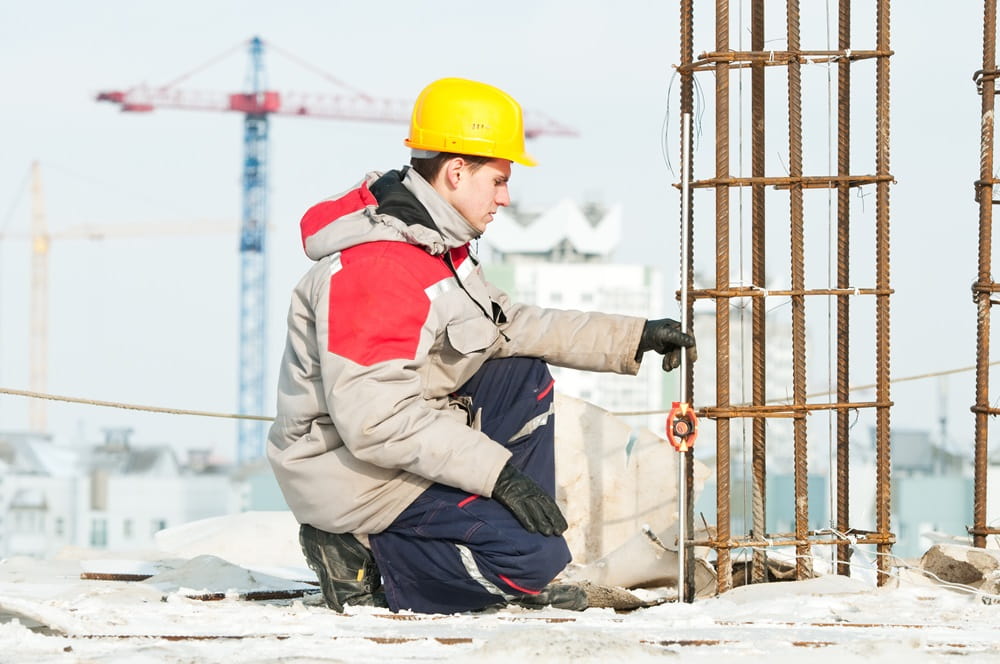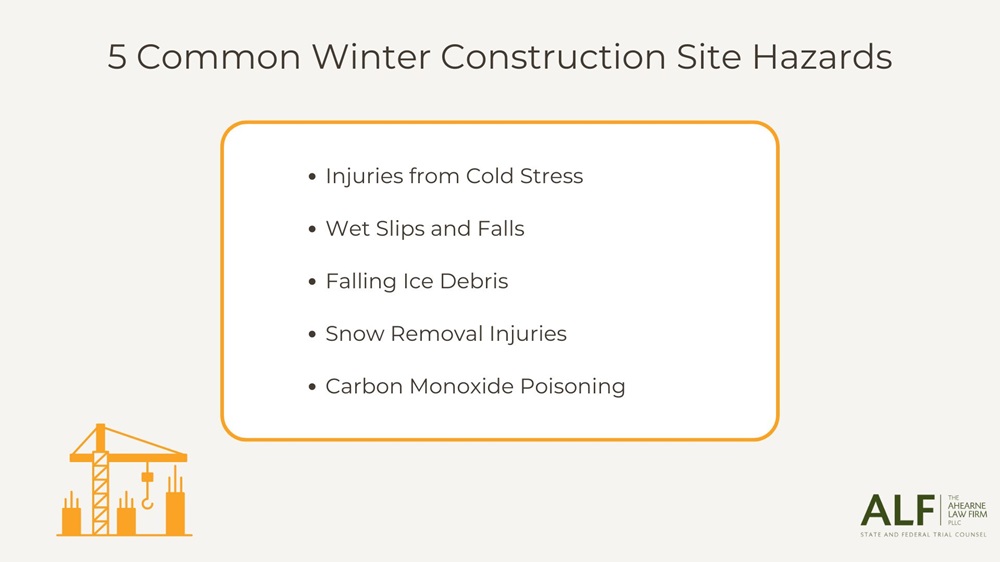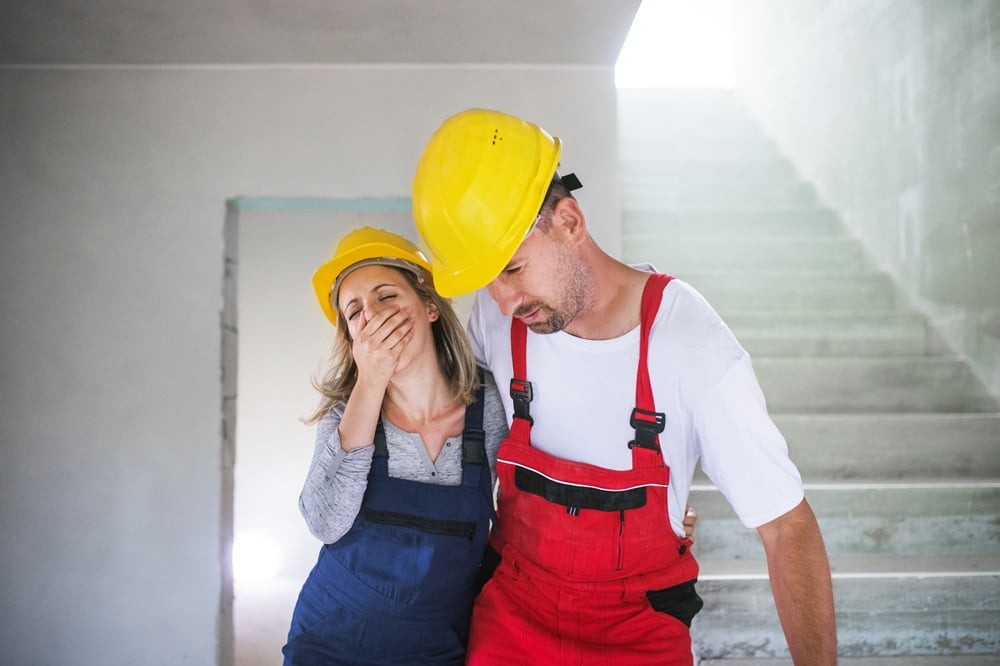Winter construction presents unique challenges that can significantly increase the risk of accidents and injuries.
Braving the elements is part of the job for construction workers. Nonetheless, it’s essential to prioritize safety when temperatures plummet. By adhering to specific safety protocols and being aware of potential hazards, construction companies can mitigate risks and protect their workforce.
If you or a loved one has been injured in a construction accident due to unsafe conditions, our Hudson Valley construction accident lawyers can help. We understand the complexities of these cases and can effectively fight for the compensation you deserve.
Before we go into detail, here’s a mini-table providing an overview of our top 10 tips:
| Winter Weather Construction Safety Tip | Description |
|---|---|
| 1. Clear the site | Inspect the job site and clear it of hazards. |
| 2. Check the weather | Monitor the weather forecast and adjust work tasks accordingly. |
| 3. Set up a heated break zone | Give workers a warm place to rest. |
| 4. Issue proper safety gear | Equip workers with necessary protective gear. |
| 5. Let equipment warm up | Allow equipment to warm up before use. |
| 6. Wear layers | Advise workers to dress warmly to retain heat. |
| 7. Keep an emergency kit handy | Stock the job site with emergency supplies. |
| 8. Stay hydrated and nourished | Encourage workers to consume warm fluids and healthy foods. |
| 9. Provide adequate lighting | Ensure sufficient illumination for safe work. |
| 10. Organize the construction site | Maintain a clean and orderly job site. |
While you’re at it, check out OSHA’s guidelines for working in cold weather.
10 Tips for Cold-Weather Construction Work
Without further ado, here are 10 helpful tips for keeping your construction crew safe when the weather outside is frightful:
1. Prepare the Worksite
Before work commences each day, thoroughly inspect the job site for potential winter-weather hazards. This includes clearing walkways and working surfaces of snow and ice, addressing frozen ground conditions, and removing any debris that could become projectiles in high winds. Proper site preparation is critical for preventing slips, falls, and other accidents.
2. Stay Informed About the Weather
Understanding the conditions you’re dealing with is essential for planning and adjusting work schedules accordingly. Monitor weather forecasts closely, especially for severe winter weather alerts. If conditions become dangerously cold or icy, consider delaying or canceling work altogether.
By being proactive about monitoring the weather, you can avoid putting workers at unnecessary risk.
3. Provide a Warm Place for Breaks
Construction workers expend significant energy in cold conditions. Providing a heated break area will allow them to warm up, rest, and maintain their strength. This space should be accessible, well-ventilated, and equipped with basic amenities. Encouraging frequent breaks helps prevent cold-related illnesses and improves overall worker well-being.
4. Equip Workers with Essential Protective Gear

Personal protective equipment (PPE) is important for safeguarding workers from cold weather hazards. This includes insulated and waterproof boots, gloves, hats, and face masks. Combining a moisture-wicking inner layer and a waterproof outer layer can also help combat the cold in frigid conditions.
Ensuring that workers have the appropriate PPE for the weather is a non-negotiable construction site safety measure.
5. Get Equipment Ready for Cold Temperatures
Before operating heavy equipment or using power tools in the cold, it’s a good idea to allow them to warm up. Cold equipment can malfunction, and frozen lubricants may not be as effective. Make it a point to follow the manufacturer’s instructions for cold weather operations to prevent accidents.
6. Dress Appropriately
Wearing layers is the best way to stay warm in cold weather. The inner layer should wick away moisture, the middle layer should provide insulation, and the outer layer should be water and windproof. Advise workers to wear appropriate clothing and to remove wet clothing as soon as possible to prevent heat loss.
7. Keep Emergency Supplies on Hand
Every work vehicle and outbuilding should be equipped with an emergency kit containing essential items for surviving unexpected winter conditions, including blankets, warm clothing, food, water, a flashlight, a first aid kit, and a charged cell phone. These supplies could be life-saving if breakdowns or unexpected weather events occur.
8. Stress Proper Hydration and Nutrition
Staying hydrated and fed is vital for maintaining body temperature and energy levels in cold weather. Encourage workers to consume warm fluids and high-energy foods throughout the day. Provide access to warm coffee, tea, or warm drinking water and healthy snacks to support overall well-being.
9. Make Sure Lighting Conditions Are Sufficient
Winter days are shorter, and daylight hours are limited. Ensure adequate lighting on the job site to prevent accidents caused by poor visibility. Install temporary lighting as needed, and instruct workers to wear reflective clothing for added visibility.
10. Get Organized
A well-organized job site is a must to promote safety in all conditions. Take extra care to keep walkways and work areas free of clutter and debris, especially during winter when traction and visibility may be reduced. Inspect the job site regularly for potential hazards and address them promptly to maintain a safe working environment.
Common Construction Hazards in Winter and How to Stay Safe

A study by the National Center for Health Statistics analyzing U.S. death records from 2006 to 2010 found an average of around 1,300 annual fatalities attributed to extreme cold exposure. During the winter months, New York City frequently experiences freezing temperatures that plunge into the 20º Fahrenheit range and occasionally below.
It’s no wonder that construction work in winter brings unique challenges that can lead to a wide range of injuries. Understanding these hazards and implementing preventive measures is the answer for protecting workers and avoiding construction injury lawsuits.
Cold-Related Injuries
Cold stress is a serious health risk for construction workers exposed to low temperatures. It encompasses conditions such as frostbite, hypothermia, and trench foot.
Frostbite occurs when the skin and underlying tissues freeze. Symptoms include numbness, pain, and skin discoloration. You can protect your extremities by wearing insulated gloves and boots and taking frequent breaks in warm areas.
Hypothermia is a dangerous condition where the body’s core temperature drops dangerously low. Symptoms include shivering, confusion, and slurred speech. Layer your clothing, stay dry, and consume warm fluids to prevent hypothermia from setting in.
Trench foot occurs when the feet are wet and exposed to cold for extended periods. Symptoms include swelling, numbness, and pain. Wear waterproof boots and change wet socks immediately to keep your feet as dry as possible at all times.
Slips and Falls
Icy and snowy conditions create a significant risk of slips and falls, one of the leading causes of death in the construction industry. Here are some tips for preventing these accidents:
- Wear appropriate footwear with good traction.
- Use de-icing products carefully according to their instructions.
- Clear walkways and work surfaces of ice and snow promptly.
- Exercise caution when working on elevated surfaces.
- Use handrails and ladders safely.
Additionally, workers should receive frequent reminders to watch their footing, especially in areas posing an increased risk of falls.
Carbon Monoxide Poisoning

Running generators, heaters, and other fuel-powered equipment in enclosed spaces can lead to carbon monoxide poisoning. To prevent this deadly hazard, only use such equipment outdoors or in well-ventilated areas and install carbon monoxide detectors, if possible.
It’s also smart to familiarize yourself with the symptoms of carbon monoxide poisoning, which include headache, dizziness, and nausea.
Snow Removal Equipment Injuries
Snow removal equipment can be dangerous if not used properly. Always follow the manufacturer’s instructions for operating equipment. Be aware of your surroundings to avoid hitting pedestrians or objects, and clear exhaust vents of snow to prevent carbon monoxide poisoning.
Falling Ice Debris
Ice and snow accumulating on roofs and tall equipment can create dangers in the form of falling debris. To mitigate this risk, inspect roofs and equipment regularly and remove ice buildup as soon as you spot it. Wear hard hats and safety glasses to protect against falling objects.
